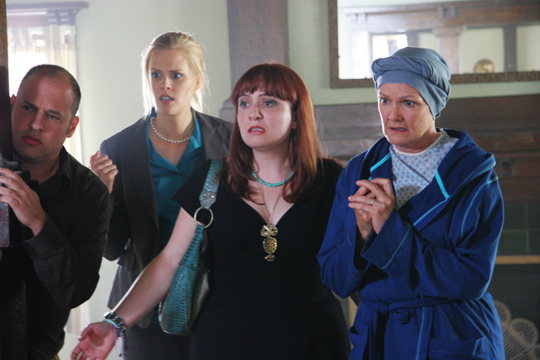
Upon stepping over the threshold and passing through the old, wooden church doors I glanced around the room, rather timidly. The mere presence of the old establishment was quite intimidating. The building’s old-fashioned, pale yellow, brown, and red ceilings and floors were a strange sight to behold, having become used to the hospital-like bleached white walls of the college and of my own home. It was eerily and all at the same time beautifully lit; there was something charming about the way the aged, golden yellow lanterns on the wall touched the walls of the lobby. I was a little nervous about volunteering for the Prescott Film Festival, but the old churches’ appeal somehow illuminated how little there was to fear about the small but perfect revenue.

It was at the ticket-desk that I found the director of the film festival. He was a stern-looking older man with apparent enthusiasm for his work. He told me and another volunteer to begin scrawling out the names of the short and feature-length films that we would be showing that day. Soon what started out as slow-paced work to keep the surplus of volunteers busy became the frantic writing of movie titles to the point where our hands began to cramp as the crowds came flooding in, unexpectedly. Several of the volunteers took tickets and directed the audience to their seats as I handed out ballets so that they could vote for their favorite feature film or short. I believe that we, as volunteers, are crucial ingredients to the film festival. It is important to present an air of professionalism and courteousness when showing a film or films in special avenues or during events such as the Prescott Film Festival. Ticket-taking and handing out ballots may not seem the most vital of jobs during a film festival, but the festival could hardly have been done without such services.

(Independent filmmaker, director, and writer, Jamie Babbit. A personal idol)
At one point during the screenings, several volunteers were allowed to be seated and view a feature-length film called, The Selling. Directed and produced by Emily Lou, the selling is a film about an unsellable, haunted residence where a murderer had once lived (and died) and killed a gross amount of people (a dozen or so). A kind, timid, and unfortunately for him, honest real-estate seller (played by Gabriel Diani, also a producer and the sole writer of the project) took on the property in attempts to sell it in order to pay for his mother’s cancer treatments. The film was hilarious and I was fortunate enough to only be sat a few seats away from the writer, producers, director, and actors of the film. It was an incredible way to experience watching the film, having been sat so close to the cast and members of the film team; to hear their reactions, laughter, muttering, and inside jokes. I was in rapture of the entire experience, and although it was only a small-niche film I feel very blessed to have experienced the film the way I did.
I learned so much about what creating films and what slaving over one’s work can yield: amazing memories, new unforgettable relationships with co-workers, and a memorable work of art for (hopefully) all to see and appreciate. I would love to learn more about creating short and feature length films! From the cast of The Selling’s commentary after the film, each member of the team recounted their experience during the project and I felt such pride and accomplishment radiating from each different speaker. I think that working on set of a small or a large film such as The Selling would help me learn so much more about independent filmmaking, and I would definitely be grateful for an experience like that.
One thing that really hit home with me about making independent films from the Prescott Film Festival was one simple and underlying fact: it takes money to make a film. Yes, even when doing small, niche films like The Selling, films cost a lot of money to finance. This fact makes independent film a hard piece of art to put forth into the world (which worries me, as a young film major).

Film festivals are so incredibly important to communities, especially small communities including Prescott. I believe that without art, life is not worth living. Audiences, Adults and children alike, feel inclined to let their imaginations run wild; to dream. Without art, aspiring filmmakers would be lost. Sometimes when one knows what one loves to do, such as creating hilarious, inspirational, dreamlike films, one must do just that. It is not a matter of choice. No matter how much the job pays materially, working in film amongst amazing artists, writers, and actors is worth it.
I will most definitely be going to see more independent films in the future, specifically in film festivals. I’ve always been a dedicated independent film fan and follower, but because I have been fortunate enough to be involved in the Prescott Film Festival, I will now undoubtedly be an avid film festival go-er. I’m aware of Flagstaff’s regular film festivals and I will be attending their festivals as often as I can. I look very forward to becoming further immersed in the independent film community.




